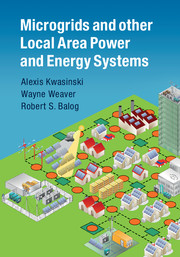Preface
Published online by Cambridge University Press: 05 July 2016
Summary
It can be said that this book loosely originated at the University of Illinois at Urbana-Champaign where the three authors met during graduate studies under the advising of Professor Philip T. Krein. It was likely the combination of this enlightening environment and our combined perspectives from past industry experience that caused the three of us to gravitate toward studying microgrids. Although the concept of microgrids implied revisiting a ideas initially proposed by Thomas Edison, much of the technology had obviously changed since the late 1800s. Perhaps the most significant is that, power electronics now provides the ability to step-up or step-down dc voltage, a flexibility that Edison's concept lacked. Today, in modern large interconnected power grids, the need for integrating new technologies (such as renewable energy sources and energy storage) has also led to a search for new technological solutions and, in particular, modern microgrids have emerged. Still, during the first decade of the twenty-first century, when we were together at the University of Illinois, the concept of microgrids was not mainstream and the focus of most University power programs were staunchly divided between power systems and power electronics. Power systems studies tended to center their attention on large conventional interconnected power grids. Power electronics programs were mostly oriented to circuit topologies, devices, or control analysis. Microgrids represented, at the time, a bridge between these two large areas of study of power systems and power electronics in to a new research area that could be called power electronics systems. Hence, the study of microgrids and what we call in this book local area power and energy systems represented pioneering work, not only because it bridged power systems and power electronics, but because of the enormous potential applications for this technology and impact on society. For example, in the United States microgrids became a mainstream technology for improved power resilience to natural disasters after Superstorm Sandy affected New York City and the New Jersey Shore in late 2012, but this technological relevance of microgrids had already been identified by us in 2005 after studying the effects of Hurricane Katrina on critical power infrastructure.
- Type
- Chapter
- Information
- Microgrids and other Local Area Power and Energy Systems , pp. xi - xivPublisher: Cambridge University PressPrint publication year: 2016



